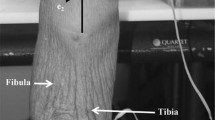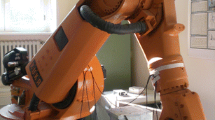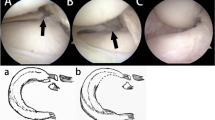Abstract
Purpose
Tears of the posterior horn of the medial meniscus (PHMM) are very common in the ACL-deficient knee. Specific lesions of the PHMM have been described in the setting of ACL rupture: ramp lesions and injuries to the meniscotibial ligament. There are little data available regarding the role these lesions play in knee instability. The aim of this study is to analyse the biomechanical consequences of ramp and meniscotibial ligament lesions on knee stability. Our hypothesis was that these lesions would cause increased instability in the setting of ACL rupture.
Methods
A cadaveric study was undertaken: ten knees were included for analysis. The biomechanical repercussions of different meniscoligamentous injuries were studied in four stages: stage 1 involved testing the intact knee, stage 2 after transection of the ACL, stage 3 following creation of a ramp lesion, and stage 4 after detachment of the meniscotibial ligament. Four parameters were measured during the experiment: anterior tibial translation under a force of 134 N, internal and external tibial rotation under a torque of 5 Nm, and valgus angulation under a torque of 10 Nm. Measurements were taken in four knee flexion positions: 0° or full extension, 30°, 70°, and 90° of flexion.
Results
There was a statistically significant increase in anterior tibial translation for stage 2 (6.8 ± 1.3 mm, p ≤ 0.001), stage 3 (9.4 ± 1.3 mm, p ≤ 0.001), and stage 4 (9.3 ± 1.3 mm, p ≤ 0.001) compared to stage 1. There was no significant difference between stage 2 and stage 3 (2.6 mm, n.s.) or stage 4 (2.5 mm, n.s.). We did, however, demonstrate an increase in anterior tibial translation of 2.6 mm after the creation on a lesion of the PHMM compared to isolated division of the ACL, for all flexion angles combined. There was an increase in internal tibial rotation between stage 1 and stage 4 (3.2° ± 0.7°, p ≤ 0.001) and between stage 2 and stage 4 (2.0° ± 0.7°, p = 0.023). A significant difference was demonstrated for external rotation under 5 Nm torque between stages 4 and 1 (2.2° ± 0.5°, p ≤ 0.001) and between stages 4 and 2 (1.7° ± 0.5°, p = 0.007) for all knee flexion angles combined. No created lesion had a significant effect on medial laxity under a 10-Nm valgus torque at any degree of knee flexion.
Conclusion
Lesions of the posterior horn of the medial meniscus are frequent in cases of anterior cruciate ligament rupture. These lesions appear to play a significant role in knee stability. Ramp lesions increase the forces in the ACL, and the PHMM is a secondary restraint to anterior tibial translation. Lesions of the meniscotibial ligament may increase rotatory instability of the knee.





Similar content being viewed by others
References
Ahn JH, Bae TS, Kang K-S, Kang SY, Lee SH (2011) Longitudinal tear of the medial meniscus posterior horn in the anterior cruciate ligament-deficient knee significantly influences anterior stability. Am J Sports Med 39:2187–2193
Allaire R, Muriuki M, Gilbertson L, Harner CD (2008) Biomechanical consequences of a tear of the posterior root of the medial meniscus. Similar to total meniscectomy. J Bone Joint Surg Am 90:1922–1931
Allen CR, Wong EK, Livesay GA, Sakane M, Fu FH, Woo SL (2000) Importance of the medial meniscus in the anterior cruciate ligament-deficient knee. J Orthop Res 18:109–115
Chen G, Tang X, Li Q, Zheng G, Yang T, Li J (2013) The evaluation of patient-specific factors associated with meniscal and chondral injuries accompanying ACL rupture in young adult patients. Knee Surg Sports Traumatol Arthrosc 23:792–798
Grood ES, Suntay WJ (1983) A joint coordinate system for the clinical description of three-dimensional motions: application to the knee. J Biomech 105:136–144
Levy IM, Torzilli PA, Warren RF (1982) The effect of medial meniscectomy on anterior-posterior motion of the knee. J Bone Joint Surg Am 64:883–888
Liu X, Feng H, Zhang H, Hong L, Wang XS, Zhang J (2011) Arthroscopic prevalence of ramp lesion in 868 patients with anterior cruciate ligament injury. Am J Sports Med 39:832–837
Michalitsis S, Vlychou M, Malizos KN, Thriskos P, Hantes ME (2015) Meniscal and articular cartilage lesions in the anterior cruciate ligament-deficient knee: correlation between time from injury and knee scores. Knee Surg Sports Traumatol Arthrosc 23:232–239
Musahl V, Citak M, O’Loughlin PF, Choi D, Bedi A, Pearle AD (2010) The effect of medial versus lateral meniscectomy on the stability of the anterior cruciate ligament-deficient knee. Am J Sports Med 38:1591–1597
Nam T-S, Kim MK, Ahn JH (2014) Efficacy of magnetic resonance imaging evaluation for meniscal tear in acute anterior cruciate ligament injuries. Arthroscopy 30:475–482
Papageorgiou CD, Gil JE, Kanamori A, Fenwick JA, Woo SL, Fu FH (2001) The biomechanical interdependence between the anterior cruciate ligament replacement graft and the medial meniscus. Am J Sports Med 29:226–231
Peltier A, Lording TD, Lustig S, Servien E, Maubisson L, Neyret P (2015) Posteromedial meniscal tears may be missed during anterior cruciate ligament reconstruction. Arthroscopy 31:691–698
Sharifah MIA, Lee CL, Suraya A, Johan A, Syed AFSK, Tan SP (2013) Accuracy of MRI in the diagnosis of meniscal tears in patients with chronic ACL tears. Knee Surg Sports Traumatol Arthrosc 23:826–830
Smith JP, Barrett GR (2001) Medial and lateral meniscal tear patterns in anterior cruciate ligament-deficient knees. A prospective analysis of 575 tears. Am J Sports Med 29:415–419
Sonnery-Cottet B, Conteduca J, Thaunat M, Gunepin FX, Seil R (2014) Hidden lesions of the posterior horn of the medial meniscus: a systematic arthroscopic exploration of the concealed portion of the knee. Am J Sports Med 42:921–926
Strobel M (2002) Manual of arthroscopic surgery. Michael Strobel—Springer, New York, pp 171–177
Acknowledgments
Mr Damien Goy (Bioengineering) for his advice, assistance, and investment in this study, Mr Rodolphe Testa for his aide in the interpretation of the results, the anatomy laboratory, and the staff at the Rockefeller Faculty of Medicine, Lyon Grange Blanche.
Author information
Authors and Affiliations
Corresponding author
Ethics declarations
Conflict of interest
The authors declare that they have no conflict of interest.
Rights and permissions
About this article
Cite this article
Peltier, A., Lording, T., Maubisson, L. et al. The role of the meniscotibial ligament in posteromedial rotational knee stability. Knee Surg Sports Traumatol Arthrosc 23, 2967–2973 (2015). https://doi.org/10.1007/s00167-015-3751-0
Received:
Accepted:
Published:
Issue Date:
DOI: https://doi.org/10.1007/s00167-015-3751-0




